The 2006 Animal Welfare Act requires keepers, (and those with temporary responsibility), to ensure that captive animals are provided with:
Failure to meet these needs causes significant welfare issues. For tortoises, turtles and terrapins, the environment required is species-specific and will vary considerably. Table 1 shows the chelonian/testudine species, their natural habitats and feeding habits referred to in this article. Natural environments include desert, open savannah, Mediterranean hillsides, Russian steppes, freshwater, tropical rainforest and oceans. While animals in the wild will be subject to environmental stresses, the habitat must provide sufficient opportunities to keep these within manageable limits, otherwise the species could not exist in that locale.
Maintenance in captivity, to prevent stress and to maintain good health, requires that the conditions and husbandry mimic the natural environment, providing as much enrichment as possible. Enrichment in the captive environment could include provision of a variety of substrates, surfaces and slopes; microhabitats through use of plants, rocks, shade, shelter; opportunities for basking, hiding, burrowing as illustrated in the outdoor enclosures in Figure 1 and Figure 2. This often means providing both an indoor (Figure 3) and an outdoor habitat (the former for use in colder weather; the latter for warmer summer days).
| Common Name | Latin | Countries of origin | Habitat | Habit |
|---|---|---|---|---|
| Mediterranean spur-thighed tortoise | Testudo graeca graeca/Testudo graeca ibera | Morocco, Tunisia, Libya/Turkey, Spain | Terrestrial |
Solitary |
| Mediterranean Hermann's tortoise | Testudo hermanni | France, Italy, Spain, Greece, Balkans | Terrestrial |
Solitary |
| African spurred tortoise | Geochelone/Centrochelys sulcata | Sub-Saharan Africa | Terrestrial |
Solitary — males may be agonistic |
| Horsfields tortoise | Testudo/Agrionemys horsfieldii | Eastern Russia, Afghanistan, Pakistan, China | Terrestrial |
Solitary |
| Leopard tortoise | Geochelone pardalis | South Africa, Tanzania, Kenya | Terrestrial |
Solitary |
| Egyptian tortoise | Testudo kleinmanni | Egypt | Terrestrial |
Solitary |
| Common box turtle | Terrapene species e.g. T. carolina | North America, Southern, Central and Eastern states | Semi-aquatic |
Semi-socialLive in groups around ponds |
| Red-eared terrapin | Trachemys/Pseudemys scripta elegans | North America Southern and Eastern states | Semi-aquatic |
Semi-socialLive in groups around ponds |
| Red-footed tortoise | Chelonoidis (Geochelone) carbonaria | Central America, South America | Terrestrial |
Semi-social Share shelters |
| Common snapping turtle | Chelydra serpentina | North America, South Eastern states including Florida | Aquatic | Solitary |
| Galapagos tortoises | Chelonoidis (Geochelone) nigra/spp. | Galapagos, Ecuador | Terrestrial | Share bathing pools |
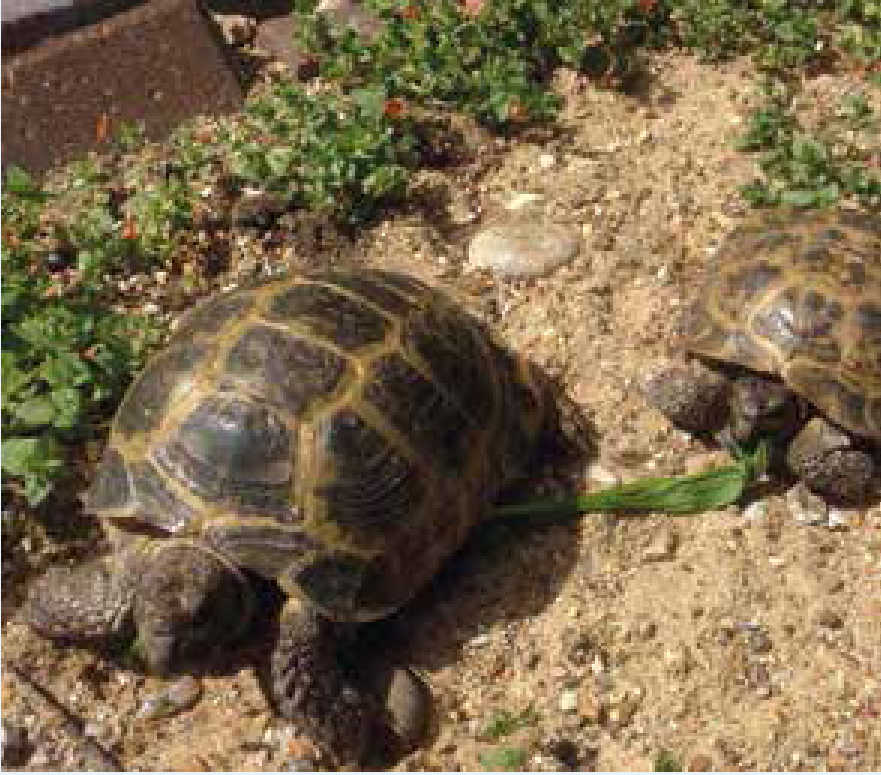
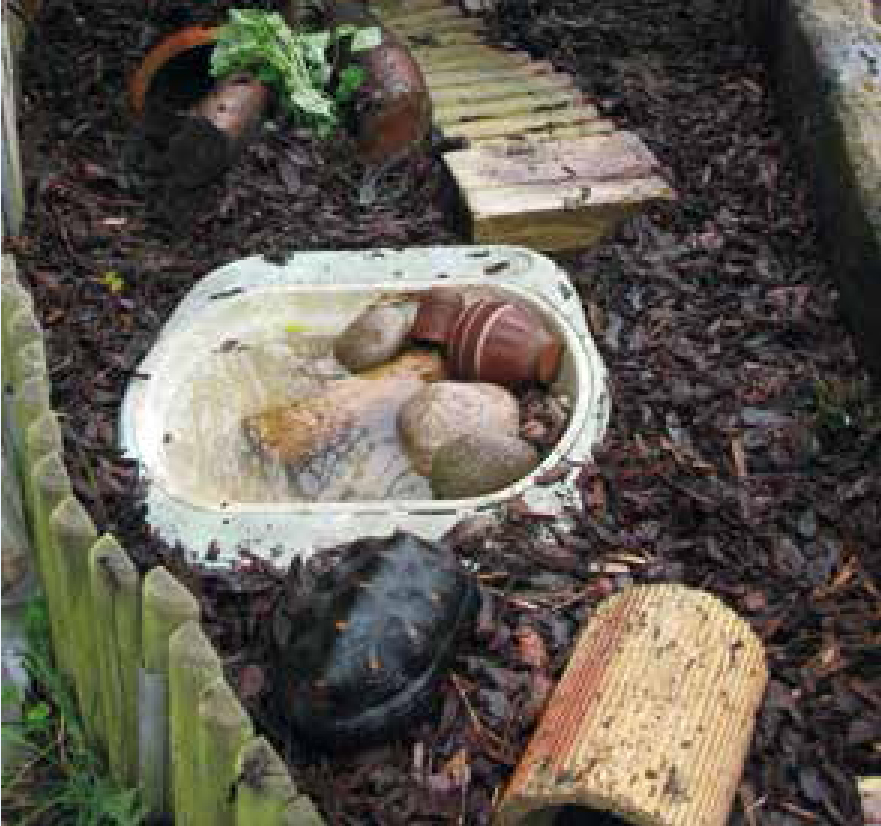
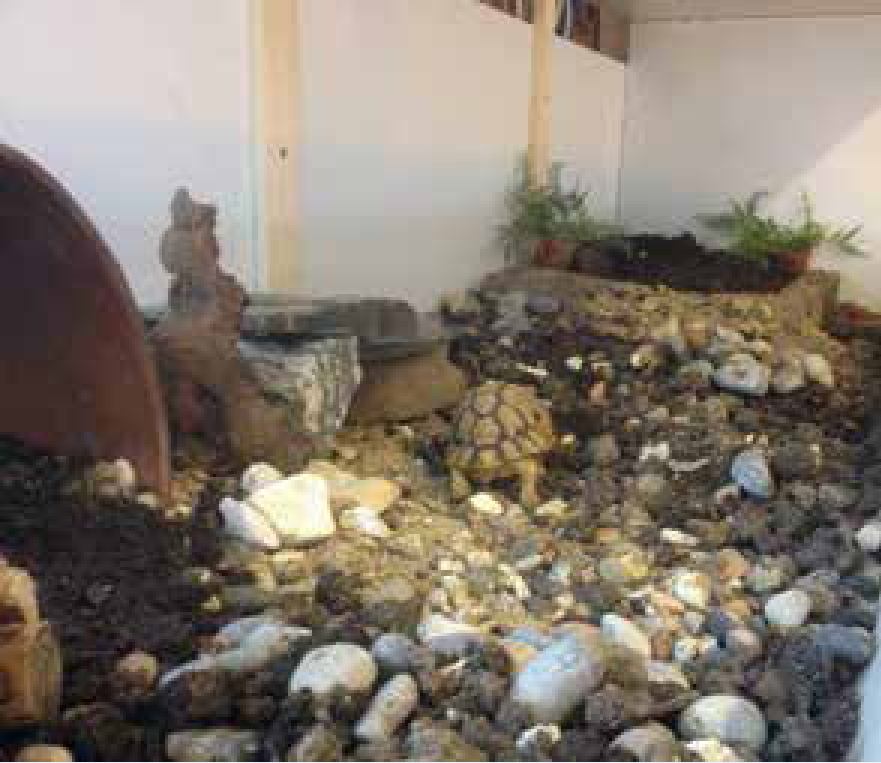
The conditions should provide:
In addition, a suitable diet for the species kept is essential for good health. Suitable veterinary treatments for gastrointestinal parasites (e.g. helminths or flagellates), injuries, and disease may be required. Often, illnesses, including abscesses or rhinitis (runny nose syndrome) urolithiasis, reproductive disease and many others, develop unnoticed for extended periods in chelonians. The physiology involved is slow — hence the condition develops very slowly and changes may be overlooked (McArthur et al, 2004) as illustrated by the very leg large abscess in Figures 4 and 5 (before and after removal respectively) which may have taken 5 years to develop.
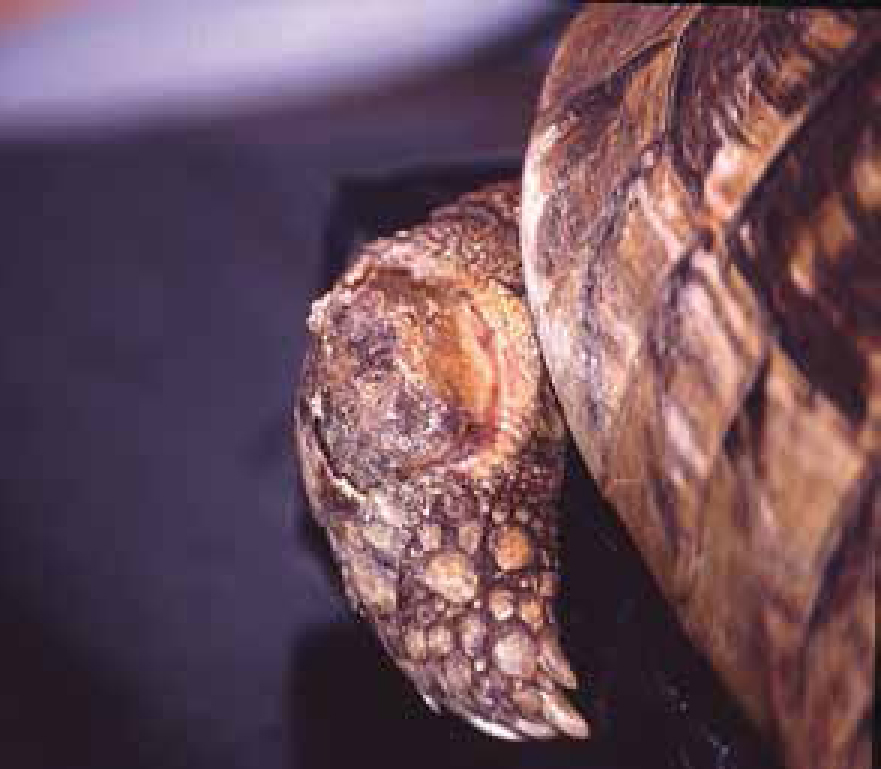
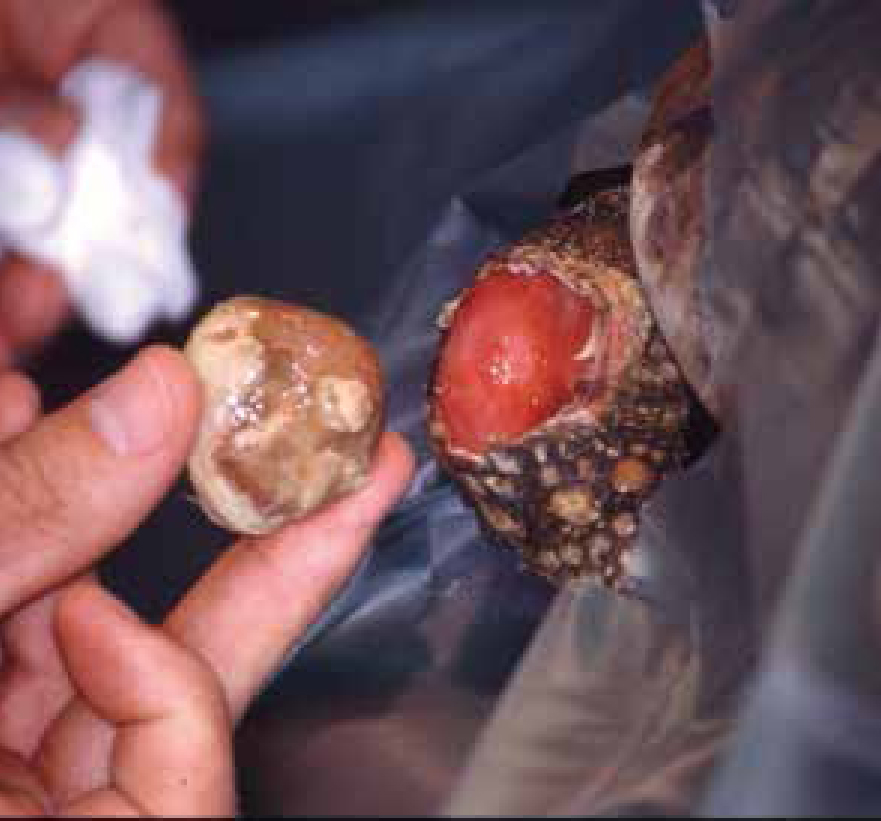
Regular monitoring of the chelonian's physical condition is essential in identifying ill-health at an early stage. Physical examination is required to ensure that swellings or abscesses are not developing. The condition of the mouth, eyes, ears and nostrils should be regularly checked for discharge, swellings or stomatitis. The condition of the skin and shell should be examined for excessive sloughing or damage. Weighing the animal each month gives a good indicator of general health in adults and growth rate in juveniles. A slow steady growth rate in juveniles, essential for healthy development, is shown in the weight chart for an Egyptian tortoise (Figure 6) (Testudo kleinmanni) hatchling.
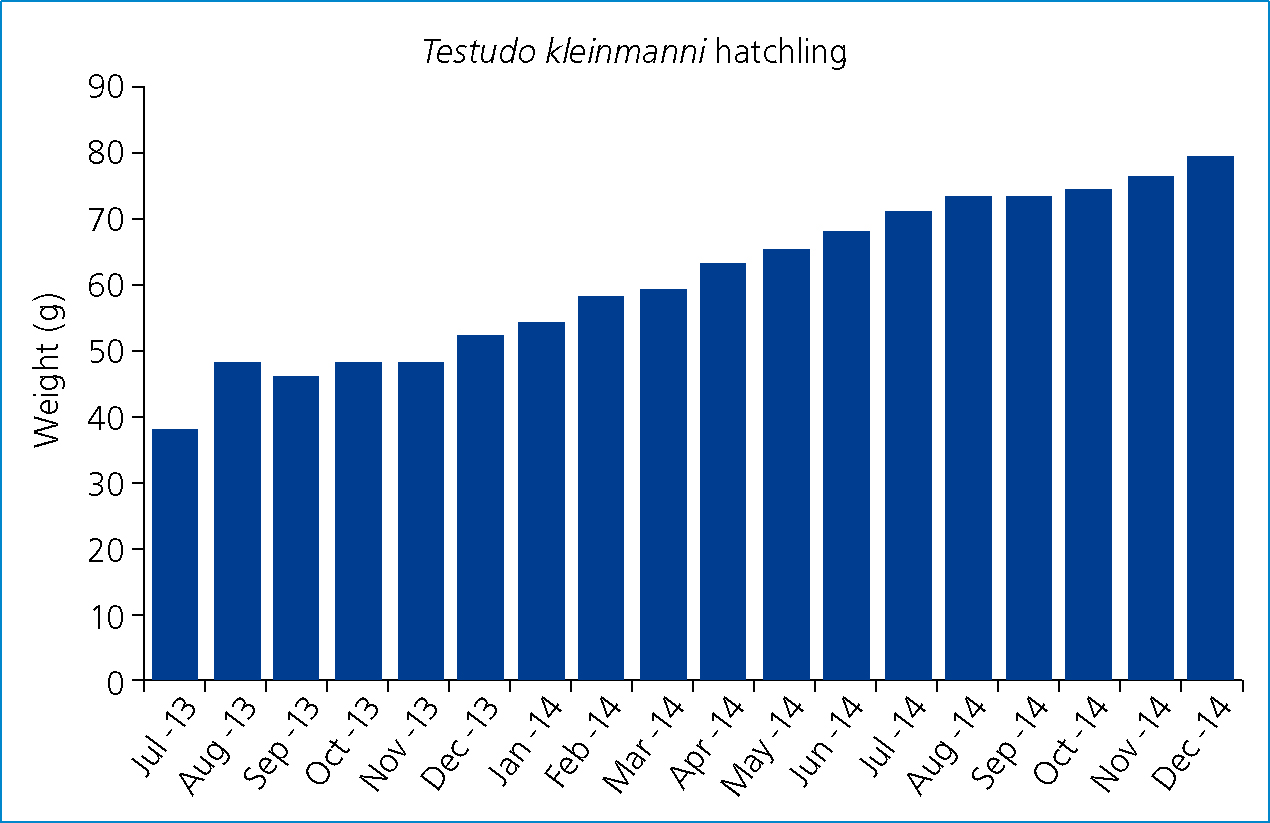
Normal behaviours — indicators of lack of stress
The physical environment should provide opportunities for maintenance of homeostasis and for the range of normal behaviours to be shown. Similarly the presence (or absence) of other chelonians may influence wellbeing and stress levels.
Daily cycles of behaviour are often seen in tortoises (Chitty and Raftery, 2013). The circadian rhythm in terrestrial species usually follows the sequence given in Figure 7.

While Testudines do not have a complex social environment — as these animals are often solitary – aggregation is seen in some species for mating and during annual cycles. For example, Terrapene spp. gather around ponds, during which social bullying may be seen between males. Some species show agonistic behaviours, e.g. Geochelone sulcata males will ram each other, or flip each other onto their backs, in competition for females. When juvenile Hermann's tortoises are kept together in pairs, one will always grow more quickly and will drive the smaller tortoise away from food. Female Spur-thighed tortoises will ram each other in small enclosures trying to gain access to nesting sites (Highfield, 1996).
Basking/sheltering/lighting
Suitable temperatures (species specific) are essential for all normal behaviours. Basking (preferably in natural sunlight) is an essential daily requirement (Figure 8). Ectotherms have a very limited ability to compensate for environmental temperatures above or below their preferred body temperature (PBT) (Divers, 1996); they can overheat and die very easily. They require a temperature gradient allowing them to move in and out of warm areas to maintain their PBT. In the hottest part of the day they will often be seen seeking shade (Figure 9). Artificial UV lights have progressed in recent years with the advent of good, readily available mercury vapour and T5 lamps, yet many tortoise owners are still not providing adequate UV. As well as the health implications of this, there is increasing evidence that suggests that reptiles can see into the UV spectrum in the same way that birds can, allowing detection of colour and high levels of discrimination within the environment. This probably has a behavioural benefit and it would be reasonable to believe that tortoises with an adequate amount of UVB are happier and less stressed (www.uvguide.co.uk). Once the likely UV requirement of any species of reptile is ascertained, the next step is to plan safe but effective UV gradients within the captive environment. To do this requires knowledge of the UV spectrum and output of the lamps to be used (Baines, 2016). Using the British and Irish Association of Zoos and Aquaria (BIAZA) UV tool allows the microhabitat requirements to be determined in relation to basking behaviour (Baines, 2016).
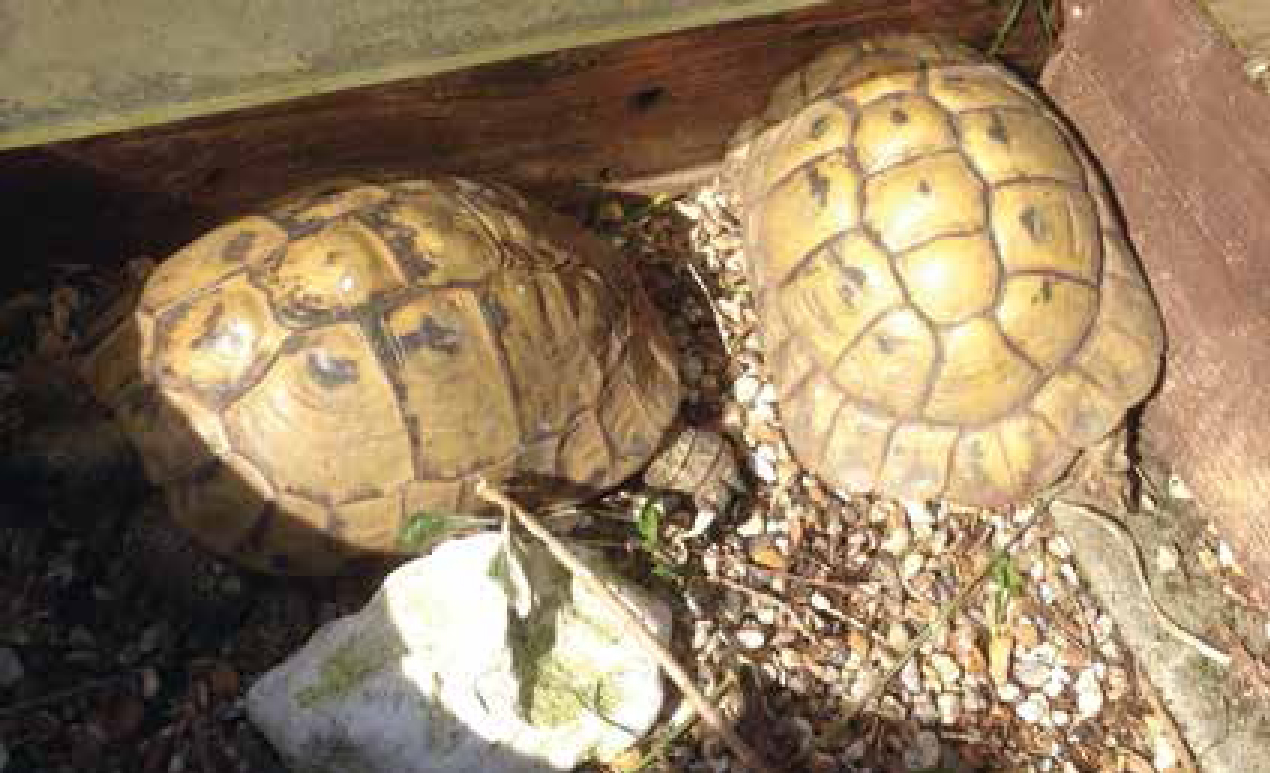
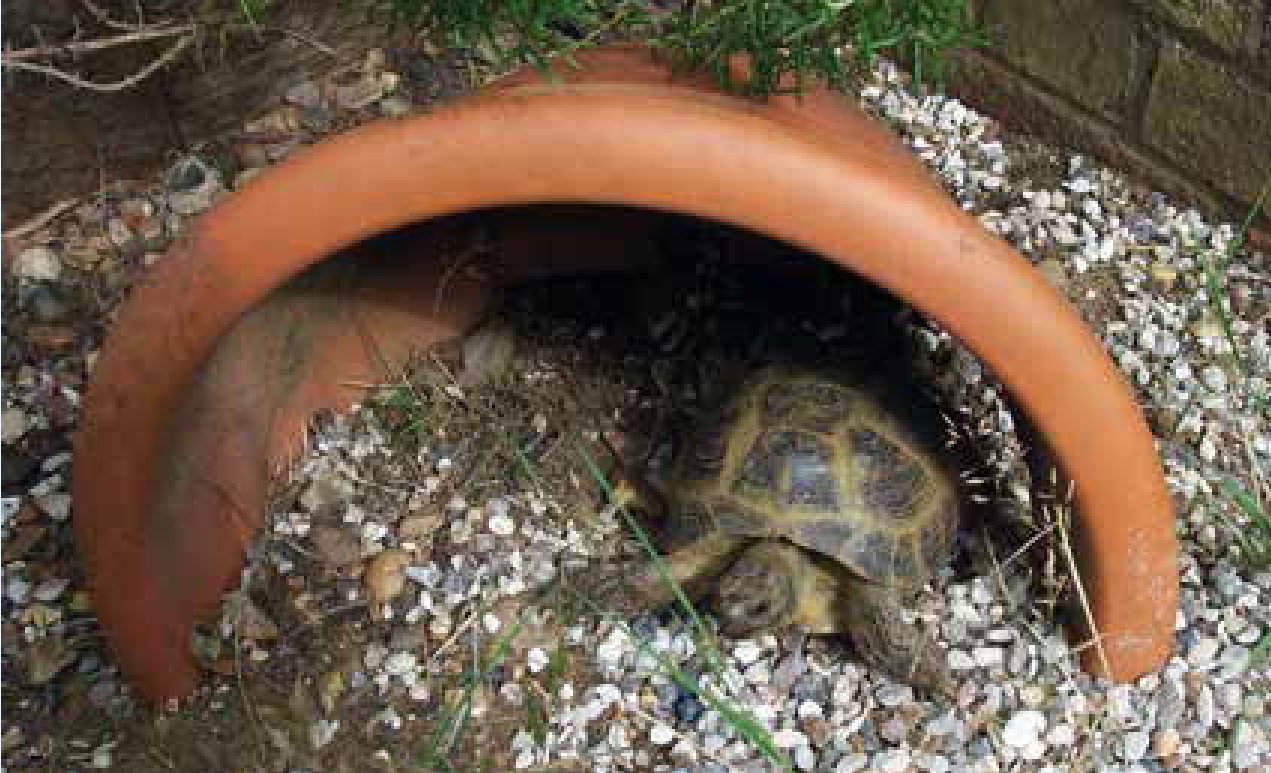
In poor hibernation conditions, they can easily freeze, causing blindness or death (McArthur, 2003). They may also wake up, urinate and return to sleep (unnoticed by the keeper) which may cause significant post hibernation morbidity.
The preferred optimum temperature zone (POTZ) is the range which allows the tortoise to maintain its (PBT) (Chitty and Raftery, 2013). Outside of this range normal metabolic activity is impaired, which affects physiology, health and recovery from illness (McArthur et al, 2004). Basking and sheltering are seen throughout the day to maintain PBT. Suitable temperatures are essential for motility of intestines; maintenance of gut flora; production of white blood cells from bone marrow; conversion of previtamin D3 to vitamin D3 in skin on exposure to UVB light (www.uvguide.co.uk).
Walking/swimming
Terrestrial tortoises spend a great deal of time in the wild walking to find food, which is not always abundant or accessible. Mediterranean tortoises, Leopard and African spurred tortoises are all known to walk several kilometres daily.
Aquatic (e.g. snapping turtles) and semi-aquatic turtles (e.g. red-eared terrapins) spend much time swimming or walking to find food. Snapping turtles are known to be ambush species and hardly move unless disturbed, while terrapins are active hunters that swim around looking for food.
Feeding
Aquatic, carnivorous species will often show a feeding frenzy in groups, presenting significant danger to small individuals or juveniles from biting injuries, e.g. common snapping turtles. Carnivores should therefore be fed individually in captivity.
Semi-aquatic and some tropical species are omnivorous, eating a range of plants, fungi, invertebrates and fruit. Redfooted tortoises are seasonal omnivores having a change in diet to take advantage of available food sources, such as snails as shown in Figure 10.
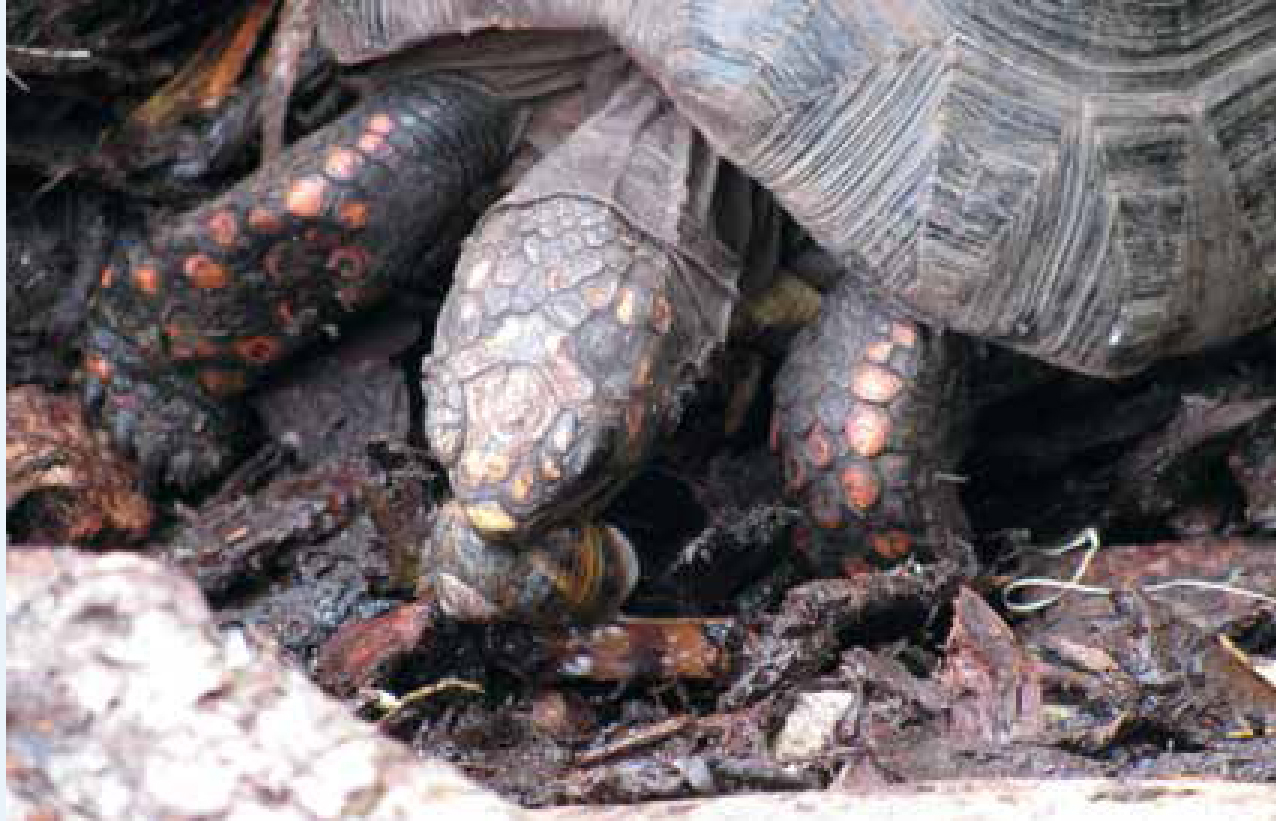
Terrestrial chelonians are often largely herbivorous, eating a wide variety of plant species — high in calcium and fibre; low in protein and fat (McArthur, 2004). Figure 11 shows a grazing African spurred tortoise — grasses are the staple diet. They spend a great deal of time walking over wide areas to find food. The diet changes seasonally, as vegetation changes during the year, e.g. lush leaves in spring or after rains, drying out later in the year or during drought. Provision of appropriately sized enclosures is therefore essential (Divers, 1996) and can be challenging in captivity. Inappropriate high energy, high protein, low fibre, low calcium diets cause abnormal growth in hatchlings leading to shell pyramiding, metabolic bone disease and vertebral collapse and many other physiological problems (Chitty and Raftery, 2013).
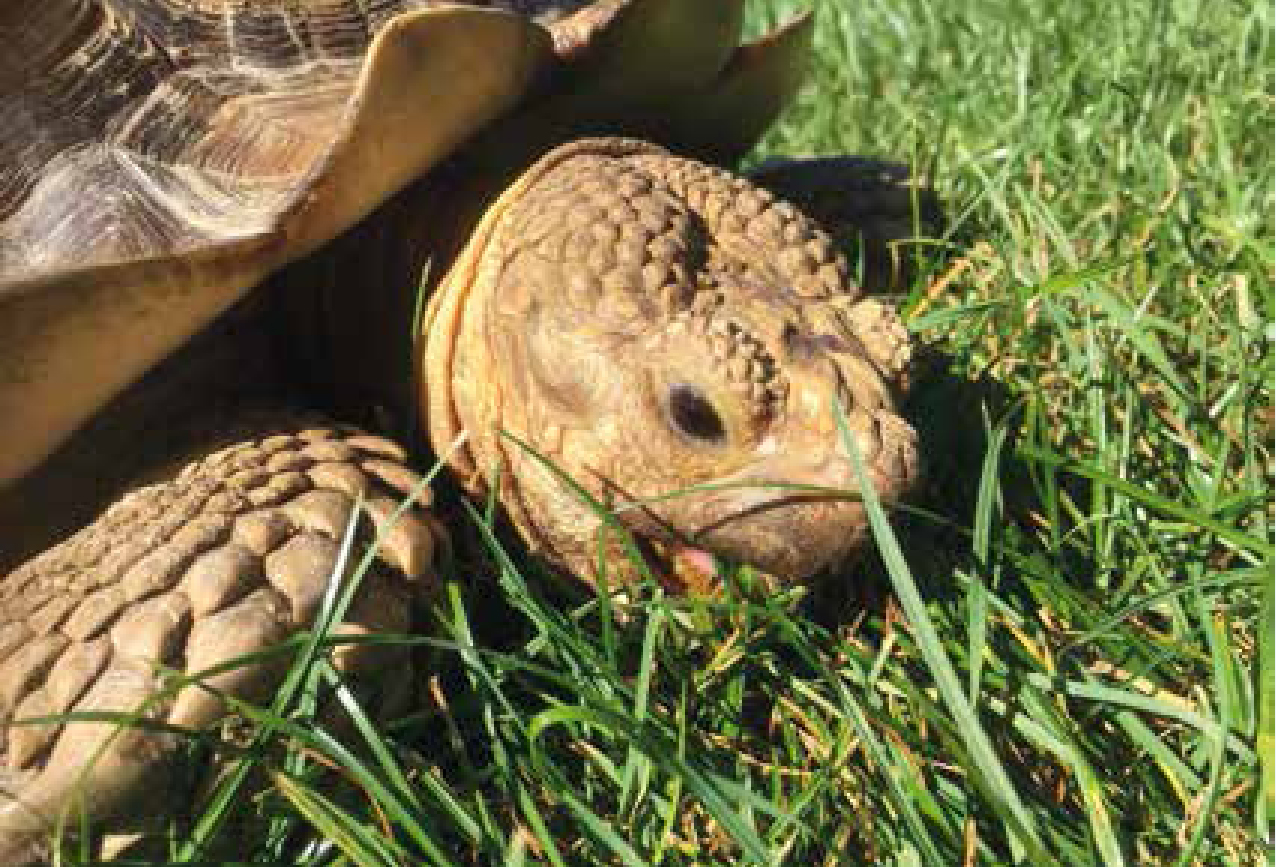
Drinking/bathing/urinating/defaecating
Terrestrial chelonians cannot take water from a small bowl. Tortoises drink by sitting in water and pumping water into the throat and the cloaca. They must be partially submerged to do so. Opportunities for drinking are limited in the wild; tortoises taking in most of their water through food. Although tortoises are physiologically adapted to make use of arid environments, they do drink in the wild when they have the opportunity. Urates and faeces are often produced while the tortoise is bathing (Figure 12), giving keepers an opportunity to check the physical appearance and consistency as indicators of good health. Tortoise faeces should be dark, well-formed and not have an unpleasant smell (Figure 13). Water should always be provided, as renal failure and urolothiasis (secondary to chronic dehydration) are commonly seen in captive tortoises. A shallow tray of clean water should always be provided. It should be sunken into the substrate so that the tortoise can climb in, and large enough for the tortoise to sit in. Alternatively the tortoise can be placed into a daily bath as shown in Figure 12.
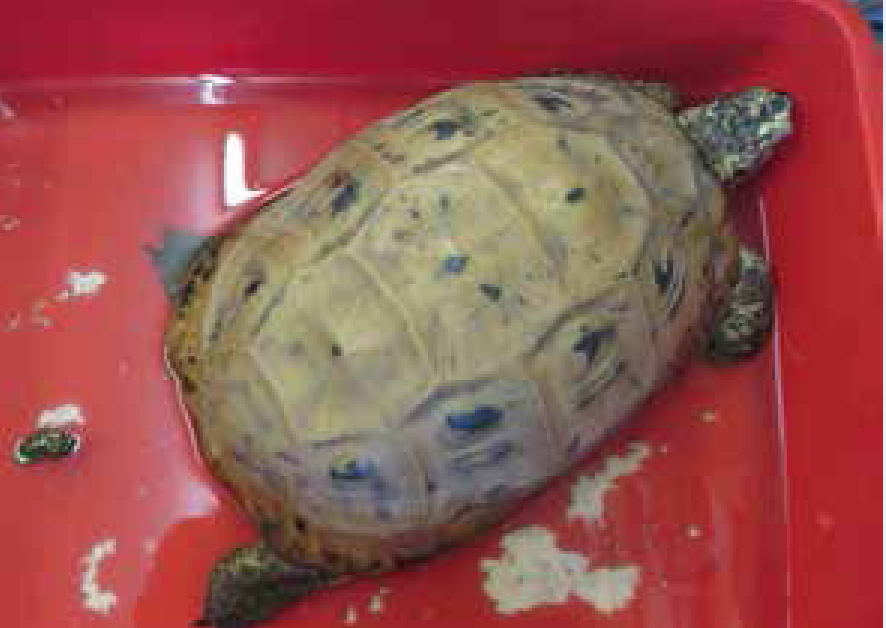

Aquatic species may also be able to draw water directly into the bladder via the cloaca.
Mating/breeding
Male Mediterranean tortoises, during warm weather, spend much of their time seeking out a female for mating purposes. This drive becomes so strong that males may stop feeding if females are unavailable. Mating rituals involve the male head bobbing followed by physical stimulation of the female through repeated ramming the back of her carapace (Spur-thighed and African spurred tortoises), or biting the back of her legs (Hermann's and Horsfields tortoises). This may cause stress, pain and damage to females (Highfield, 1996; Chitty and Raftery, 2013) especially in overcrowded situations or small enclosures. A lack of egg laying sites can contribute to dystocia and is likely to be a cause of stress in females. Figure 14 shows a female African spurred tortoise (Geochelone sulcata) nesting in loose, warm soil to produce a large clutch of 20 or more eggs (Figure 15).
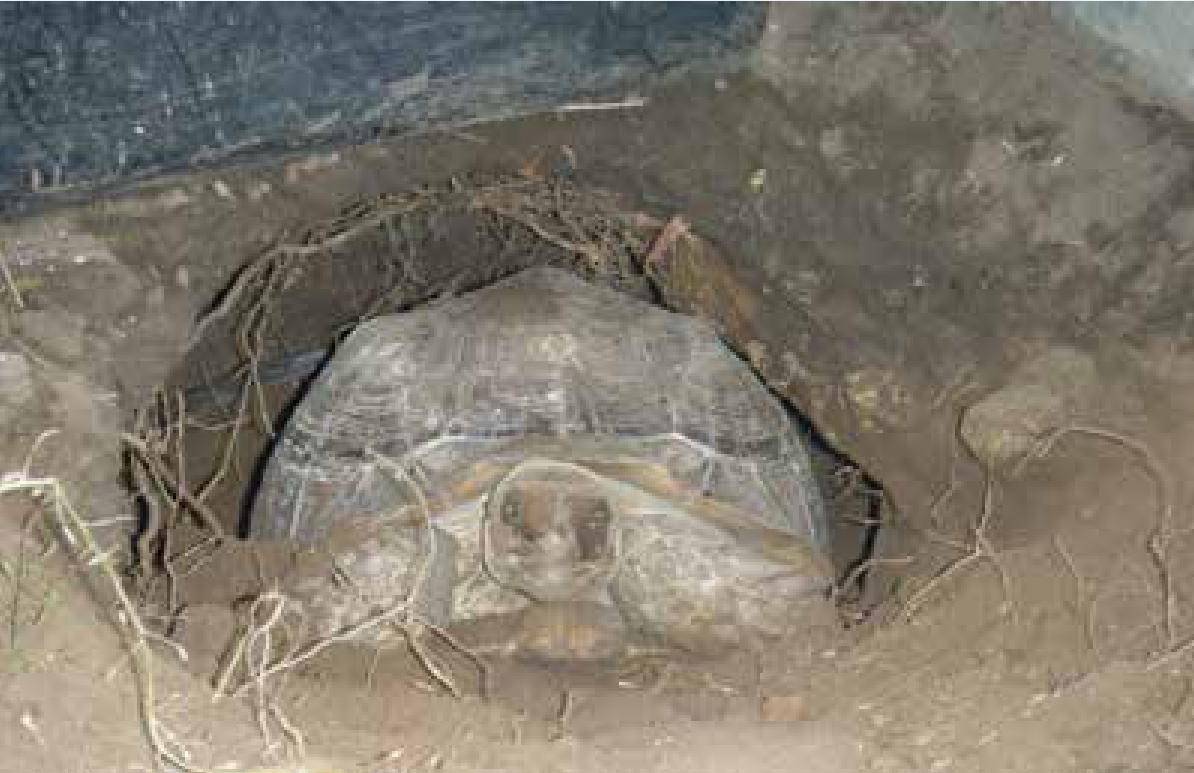
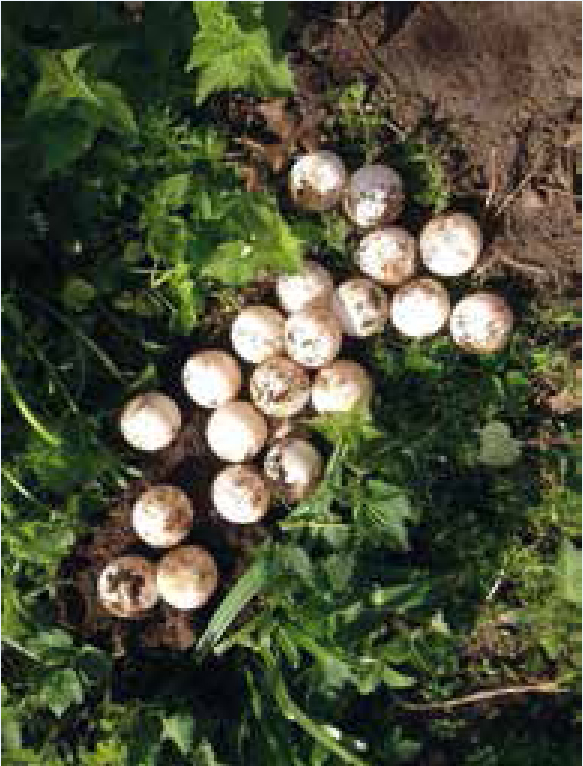
Red-footed tortoises and other tropical species such as leopard tortoises will mate throughout the year if given the right conditions.
Aquatic species may have more involved mating rituals, involving chasing and scenting the female's cloacal region. In red-eared terrapins, the male has very long front claws to fan and hold the female.
Identifying stress, distress and pain
Failure to show normal behaviours (as outlined above) is the clearest indicator, alongside physical condition and illhealth, of fear, stress or distress in chelonians (Highfield, 1996; McArthur et al, 2004). Failure to reproduce is often an indicator of environmental stress due to poor conditions or husbandry.
Identifying fearful behaviours is not easy in these animals, but when tortoises withdraw into their shell and will not protrude their head or legs, it is a clear indication that their environment has become alarming to them (McArthur et al, 2004) as illustrated by the Egyptian tortoise in Figure 16. Sudden forced ejection of large volumes of urine is commonly seen on handling or during transportation. Defaecation is also common during transportation.
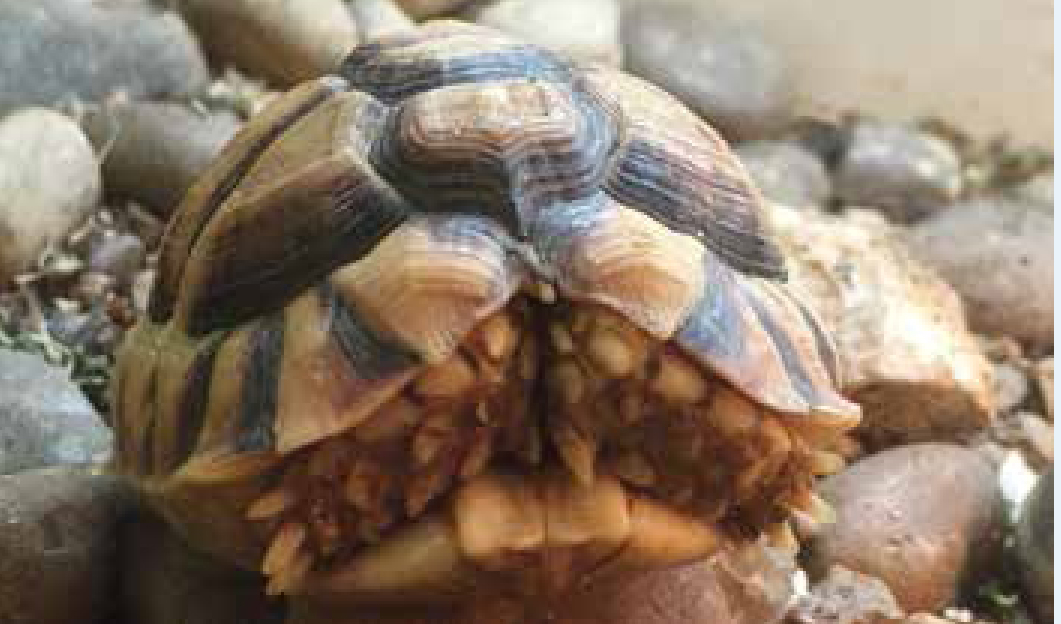
Testudines have scaly skin; they cannot show facial expressions due to the fixed scales of the head, and they have limited limb movements. All of the above make expressions of relaxation or pleasure, distress or pain difficult to identify. It is therefore very difficult to determine emotional responses from tortoises, compared with other groups such as birds or mammals.
Identifying a ‘happy’ tortoise is not usually possible. Some giant species such Galapagos tortoises may, however, appear to be content (in so far as can be determined by observation) when their limbs are rubbed (fitching) or when they present their limbs for birds to take parasites from their skin.
Vocalisations are not common in chelonians; exceptions include males during mating e.g. the ‘brrrr-brrrr-br-rrr’ of male Testudo kleinmanni during mating. Vocalisations have been observed when chelonians are in extreme pain (Chitty and Raftery, 2013). Reptile pain is, however, poorly understood and poorly described (Chitty and Raftery, 2013), but is also seen as a change in normal behaviour as shown in Table 2.
| Anorexia | Ataxia | Closed eyes |
| Resentment of palpation | Biting/rubbing lesion | Reduced/no activity |
| Dragging limbs or body | Withdrawal of head or limb(s) | Neck stretching |
| Failure to raise body from surface | Rapid rocking of front limbs (due to respiratory distress) | Vocalisations — screaming in extreme pain |
| Raising body abnormally | Lameness | Gaping |
| Urination | Defecation |
(from Chitty and Raftery, 2013)
Effects of handling and treatment
Chelonians will undergo transportation, handling, examination (e.g. palpation) and possibly invasive techniques during a trip to the veterinary practice, the effects of which are likely to be stressful.
Fazio et al (2014) found that in a study of 23 healthy juveniles (Testudo hermanni) cortisol levels were greatly increased, compared with basal values, for more than 4 weeks after handling and a short transportation experience. Their conclusions support the hypothesis that cortisol may be mediating the effects of handling and transport stress in this species.
Transportation requires use of heat pads or hot water bottles to maintain PBT and to reduce stress. A range of 24–30ºC would be appropriate (Chitty and Raftery, 2013).
Diagnosis and treatment may well require invasive techniques. Blood analysis, endoscopy and biopsy are all commonly used techniques. Ultrasound and radiography have the advantage of being non-invasive and are often possible without sedation.
Stomach tubing can be very stressful for chelonians but may be preferred to the anaesthesia risks associated with an oesophagotomy tube (Figure 17) according to Chitty and Raftery (2013). However, use of an oesophagostomy tube instead of repeated handling and manipulation of the head and limbs for gavage tubing is arguably much less stressful to the tortoise, prevents iatrogenic damage from tubing, reduces risks of regurgitation/aspiration and may result in much better outcomes.
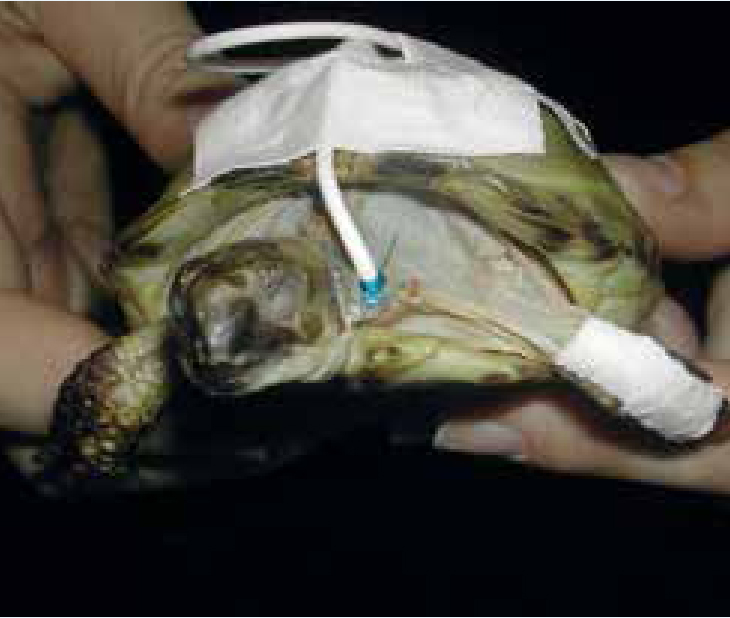
Withdrawal is seen during stressful experiences and may mean that the chelonian requires anaesthesia to carry out any procedures, even palpation. Sedation or an-aesthesia may be required in order to fully examine some species safely, e.g. dangerous snapping turtles; or because the animal can completely close the shell giving no access to head or limbs at all, e.g. American box turtles, or because of the animal's size and strength, e.g. G. sulcata.
Hospitalisation requires provision of a hygienic room or space kept at 20–25ºC. Appropriate basking temperatures and suitable temperature gradients must be provided for each animal. Suitable ventilation may be better provided by an open-top facility than an enclosed vivarium.
Chelonians can carry disease organisms transmissible to people such as Salmonella. Aquatic species require controlled access to water during recovery followed by provision of a suitable aquatic environment.
Treatment effects will be stressful and should be reduced by provision of a suitable environment to suit each species including suitable basking arrangements. This represents a significant challenge for veterinary staff and may require investment by veterinary practices if the health and welfare of the chelonian is to be effectively met while being cared for. Handling and restraint should be kept to a minimum and the animal maintained at a suitable temperature during procedures.
Conclusion
The chelonians are not well understood as a group of animals. Many species are kept in captivity as companion animals in the UK. Keeping their stress at an acceptable level is a very difficult parameter to determine. It is clear, however, that stress can be reduced by offering variety in the captive environment, so that the individual can make appropriate choices to maintain homeostasis. There are additional stresses due to handling and treatment, which should be kept to a minimum. The animal should be maintained at optimal conditions during hospitalisation and recuperation.

